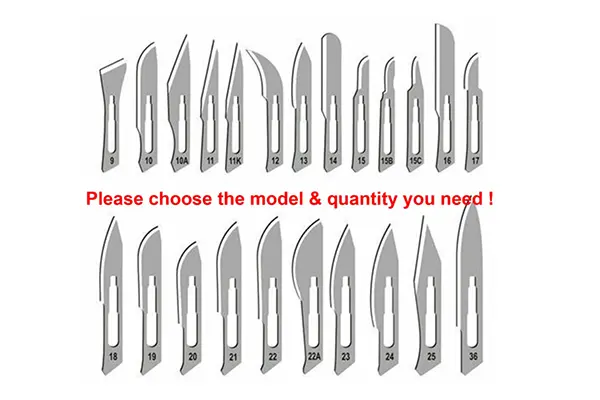Beyond Scalpels: A Surgeon's Arsenal of Blades - Unveiling the Tools of Precision
Step into the heart of a hospital - the operating room. It's a space of hushed urgency, where skilled hands wielding gleaming instruments work their magic. But among the tools, one reigns supreme: the surgical blade. But this isn't a one-size-fits-all story. Surgeons, those modern alchemists of healing, have a veritable toolbox of blades, each a tiny warrior tailored for a specific battlefield within the body. So, grab your metaphorical magnifying glass and join me as we delve into the world of surgical blades: their shapes, sizes, and the delicate dances they perform in the hands of medical maestros.
Sharper Than Wit & More Diverse Than Rainbows: Exploring the Blade Brigade
Forget your rusty kitchen knives; these blades are the crème de la crème of sharpness. Crafted from high-carbon steel for unparalleled precision and honed to perfection, they come in a bewildering array of shapes and sizes, each adapted to conquer a specific surgical challenge. Let's meet some of these cutting-edge champions:
-
The Scalpel: The undisputed king of the blade brigade, familiar even to those who've never set foot in an operating room. This versatile warrior comes in numerous sizes and shapes, from the delicate #11 for dissecting nerves to the hefty #10 for slicing through muscle and bone. Think of it as a surgeon's paintbrush, meticulously carving the path for healing.
-
The Bard-Parker Blade: Imagine a scalpel on steroids, a heavy-duty champion for tackling dense tissues and cartilage. Its broad, rectangular shape and robust construction make it the go-to for orthopedic surgeons and anyone facing tough fibrous terrain.
-
The Razor Blade: Don't picture that rusty bathroom tool! Surgical razor blades are microscopically thin blades, wielded with surgeon's grace for tasks like skin grafting and removing delicate lesions. Think of them as surgical ballerinas, pirouetting with precision on the skin's canvas.
-
The Keratome: This blade's claim to fame? Eyes. Ophthalmologists rely on these ultra-sharp, beveled blades for delicate procedures like cornea transplants, their curved shape precisely mirroring the eye's curvature. Think of them as tiny, celestial sculptors, shaping the window to the soul.
Beyond the Cutting Edge: Specialized Blades for Niche Needs
But the arsenal doesn't stop there! The world of surgical blades is a kaleidoscope of specialization, with tools for every nook and cranny of the body:
-
Bone Saws: Imagine miniature chainsaws, expertly slicing through bone as if it were cheese. These serrated wonders make light work of even the densest skeletal structures.
-
Micro-Dissection Blades: Think smaller than a hair's breadth. These microscopic blades, used in neurosurgery and plastic surgery, allow surgeons to navigate delicate tissues with unparalleled precision. Think of them as tiny fencers, parrying away disease with microscopic finesse.
-
Drainage Cannuli: Not all blades cut; some drain. Cannuli, with their hollow tips and sharp edges, create pathways for fluids to flow, preventing dangerous build-up and promoting healing. Think of them as microscopic plumbers, unclogging the body's internal rivers.
Choosing the Right Blade: Precision Makes Perfect
With such a dizzying array of options, how do surgeons choose the right blade? Think of it as a high-stakes game of "Rock, Paper, Scissors," but with scalpels, saws, and scalpels in disguise. Here's what goes into picking the perfect blade:
- Tissue type: Bone needs a different warrior than skin, and the blade must match the battlefield.
- Surgical procedure: Each procedure, from an appendectomy to a brain tumor removal, demands specific tools.
- Surgeon's preference: Comfort and familiarity play a role too, as the surgeon's confidence is crucial for a successful surgery.
Remember, surgical blades are more than just cutting tools; they are extensions of a surgeon's skill and knowledge. They dance the delicate tango of healing, wielded by steady hands and guided by sharp minds. So, the next time you hear the whisper of a scalpel in the operating room, remember the silent heroes lurking within its gleam: the blades, each a masterpiece of precision, working tirelessly to stitch together the fabric of life.
FAQ:
Q: Are surgical blades used only in surgery?
A: While predominantly used in surgery, certain specialized blades find applications in other medical procedures like biopsies and dental surgery. Ultimately, the specific blade types depend on the procedure and the medical professional performing it.
Post time: 12月-26-2023






